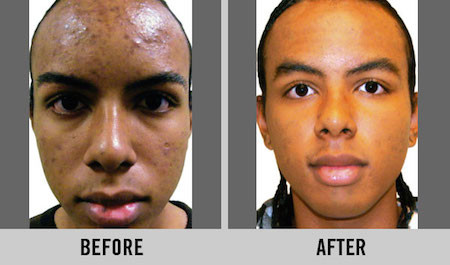
Acne scarring is a common issue. One that challenges a number of skin care professionals for the simple fact that it appears in a variety of ways. It is also difficult to treat and depending on the depth of scarring may never fully go away. There is however, much that can be done in the treatment room and at home to diminish and diffuse scar tissue, to the point that it is not visible to the naked eye.
Not only does it form differently in different skins, it may also appear in varying degrees of severity. There may be depressed scars, also known as pits, or they may take the shape of raised scars known as hypertrophic. Sometimes there may be discoloration along with it, and other times not.
Regardless, it’s something numerous clients struggle with and may, at times, significantly impact the self esteem. How do you support clients challenged with acne scars achieve a smoother, healthier skin?
It begins with understanding how scars form and why; then determining the type of scarring you are working with so that you may create a customized treatment.
Treatments to target scarring
As I mentioned certain individuals are more susceptible to scarring than others. For instance, those who have inflammatory acne (cyst and nodules) and particularly if they delay treatment, or if the individual picks or squeezes the acne, may experience scarring after the acne clears.
The potential for scarring occurs when the breakout penetrates the skin deeply, damaging the tissue beneath. Once the acne breakout clears, the body goes to work to repair the damage. This process stimulates collagen production, however if too little or too much is produced, a scar will form. In the case of the former (too little), a depressed scar may form. With the latter (too much), a raised scar may result. Prevention is key here in this scenario – if certain topicals are applied immediately and the client does not pick their skin, complete healing may occur. Home care topicals with anti-bacterials and exfoliators are invaluable as well as daily applications of epidermal growth factor. Recommend Acne Remedies Blemish Serum, BHA Refine Gel and any of our 4-epidermal growth factor preparations.
When you know the level of scarring, you are able to determine the best course of treatment.
Correcting acne scars non-invasively
There are numerous treatment methods, some of which may involve surgery. However, aesthetic professionals also have a number of non-invasive tools at their disposal to help clients smooth the scarring. In most cases it will require creating a treatment plan, one that involves several treatments and proper home care in between.
When addressing acne scarring, the ultimate goal is to remove surface cells to allow strengthening and corrective ingredients and oxygen to penetrate the skin. Overall, modalities that work to smooth acne-scarred skin in the treatment room include peels, micro-needling, and microdermabrasion.
- Peels – treating scarring will typically require a stronger formula that also delivers strengthening such as a TCA/AHA combination, flower acids like the Lotus Peel, and the Vitamin A+ Peptide Peel. One treatment that works particularly well for acne scarring is the Skinergy, which blends the TCA Sake Peel and Vitamin A+ Peptide Peel.
- Microdermabrasion – this is very effective in reducing scars as it removes cells of the stratum corneum allowing other corrective and nourishing ingredients to better penetrate the skin. A mid-depth or deep treatment will work best. It also has a smoothing effect on the skin tissue and begins to soften the scar surfacely. Keep in mind, however, the skin will be in need of strengthening from within, so if microdermabrasion is performed it is recommended to follow with a skin-strengthening peel like the Vitamin A+ Peptide Peel. (note if the skin breaks or bleeds during microdermabrasion DO NOT APPLY ACID)
- Microneedling – deeper microneedling procedures work well to remodel scar tissue, but caution must be exercised here. If pushed too deep, subcutaneous scarring may occur. Note this requires very specific training and caution is advised when combining with acids.
Depending on the client’s skin and severity of scarring, a peel may be combined with microdermabrasion. The peel is done after the microdermabrasion, for better absorption of the acid and deeper exfoliation. Use caution here, however, and be sure to read the client’s skin.
For clients on a program to correct scarring, be sure to integrate epidermal growth factors, peptides, hyaluronic acid, and essential fatty acids into their home care system. The goal is to strengthen and rebuild the skin. A mineral SPF is a must daily. In the week following the treatment, clients may also use a retinal like the Retinal Clear Complex or Salicylic A Serum to continue the gentle exfoliation and rebuilding.
Starting with the type of scar, then taking into account the client’s specific skin type, and their overall goal will help shape the type of treatment to use. We can offer our clients excellent support in this area but it is very important to not give false hope. A scar implies a permanent mark that is damaged at the cellular level. But what we can achieve surfacely for a smoother, healthier complexion is nothing less than remarkable!
Question: What is your go-to ingredient for working with skin with acne scarring?
